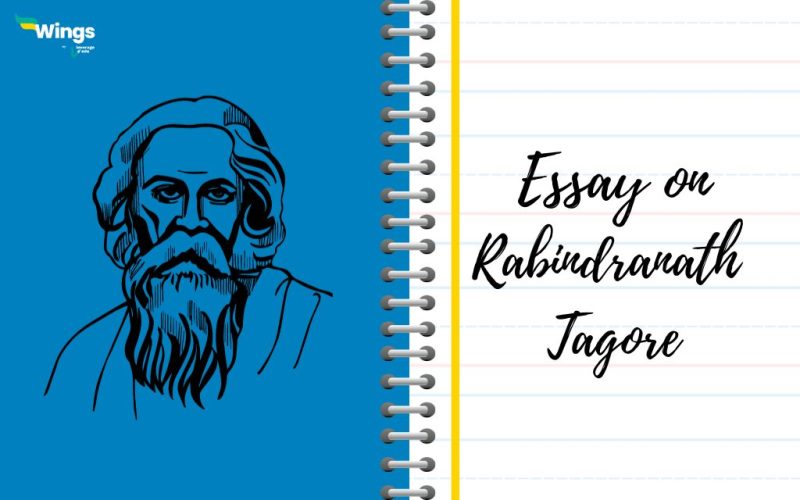Rabindranath Tagore also referred to as “Gurudev” contributed a lot to literature, art, and music. He was also a social reformer known for his famous work ‘Gitanjali’. Students in schools and colleges are taught about Rabindranath Tagore and some of his famous works are also included in the school curriculum to inspire the students and impart knowledge about different flavours he induced in Literature. This blog contains an essay on Rabindranath Tagore for school-going students. Continue Reading to delve into the life and lasting influence of Rabindranath Tagore!
Also Read: Education of Rabindranath Tagore
Short Essay on Rabindranath Tagore
Known for music, art, painting, novels, poems, stories, and composition, Rabindranath Tagore is still one of the most famous personalities in the history of Literature. He was born on 7 May 1861 in Jorasanko, Calcutta. Tagore was a Bengali Brahmin, and art and culture were in his blood. His house is a part of Rabindra Bharati University Campus.
He was the son of a religious reformer Debendranath Tagore. Rabindranath Tagore finished his education in England. Valmiki Pratibha belongs to one of his famous works.
His knowledge of art and literature seems like a treasure to those involved in the field of writing. Tagore was the first non-European who won the Nobel Prize for Literature in 1913 for his famous work ‘Gitanjali’ published in London in 1912.
One of his popular dramas was ‘Visarjan’. Tagore’s first short story was named Bhikarini. Rabindranath Tagore was a nationalist and a huge patriot as he supported India for the Freedom struggle.
Also Read – Essay on Chandrayaan-3
Essay on Rabindranath Tagore in 250 Words
The Legendary Indian poet, Rabindranath Tagore was born in 1861 in Calcutta. He started writing at a very young age. People look up to him in the field of Literature because he was exceptionally talented.
He is immortal in his field of art. Tagore is remembered for his famous works like Gitanjali, Gora, Kabuliwala, Muktadhara, The Post Office, and many more. One of his famous paintings was The Dancing Women. His artwork is making India proud as it is showcased at exhibitions in Paris and London.
Valmiki Pratibha and Visarjan belong to his collection of famous dramas. Rabindranath Tagore wrote 84 short stories known as Galpaguchchha during the period 1891-1895.
He was a great lyricist as he had penned down 2000+ songs out of which two were chosen by India and Bangladesh as their National Anthems. The songs written by Rabindranath Tagore reflect the Indian culture and are referred to as “Rabindra Sangeet”.
His work also boosted and infused the feeling of patriotism during the Indian Freedom struggle. Tagore’s work reflects his strong political opinion against British Rule. In 1919, he also participated in a protest of the Jallianwala Bagh massacre.
People in India named Rabindranath Tagore as “Gurudev,” “Kobiguru,” and “Biswakobi.” He was a multi-talented personality noted for his significant contributions to literature, art, politics, and music. The famous poet, dramatist, and philosopher died on 7 August 1941, at his ancestral home in Jorasanko, which is now a part of Rabindra Bharati University Campus.
The entire world will always remember him for his exceptional work and contributions in Literature, art, and science. To pay him honour we celebrate Rabindranath Tagore Jayanti on 9 May every year.
Related Articles:
FAQs
Rabindranath Tagore was a renowned writer, poet, novelist, painter, composer, and nationalist who had achieved immense success in Literature. In 1913, he also received the Nobel Prize in Literature for his famous work ‘Gitanjali.’
Rabindranath Tagore is counted among the greatest minds of India and also known as the world poet. He is famous for his works ‘Gitanjali’ and ‘Jeevan Smriti’. Apart from these, Tagore has composed more than 2000 songs. He is also known for his dramas, poems, stories, and novels.
Rabindranath Tagore won the Noble Prize in 1913 in Literature for his collection ‘Gitanjali’ which was published in London in 1912.
This was all about an essay on Rabindranath Tagore. For more information about such interesting topics, visit our essay writing website and make sure to follow Leverage Edu.
 One app for all your study abroad needs
One app for all your study abroad needs













